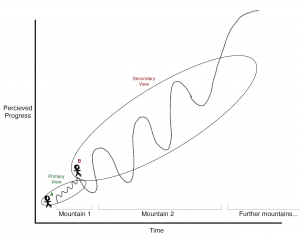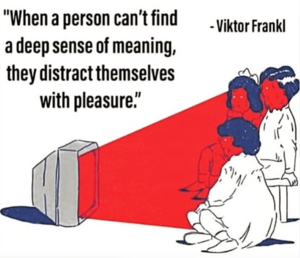Technological pacification

Society endeavours to meet our every need, however when these needs are met there are always more... It's like climbing a mountain, and once getting to the top you only see another much bigger mountain (Figure 1). This process reflects our most primal neurochemical pathways that have been created to make all life productive.
Paranoia primes us to believe that there is one villain causing this, the Rothschilds, the Illuminati or Darth Vader... but in fact, there is no conspiracy or one person to blame it is simply an emergent phenomenon of the system we are in.
Cultural Pacification
Media, computer games, smartphones and certain medicines are not unlike adult pacifiers.[1] Whilst babies have a need for soothing with milk from the mother's teat, adults have more complicated desires. Could it be that tolerance in the wider world for despots has occurred as our inventions provide an escape for our warriors (Figure 2)? Is the bread and circuses analogy true?
Medical Pacification
5.0% of adults in the world suffer from depression[2]. The brain plays crucial roles in promoting survival and reproduction, so the pressures of evolution should have left our brains resistant to such high rates of malfunction. Mental disorders should generally be rare and be getting rarer — so why is depression so common and even more growing?
Depression is a subjective issue with little to no objective parameters, one can only assume that the disease is partly caused by internal biochemistry and external circumstance. Part of the appeal of the internal biochemistry rationale is its apparent simplicity, efficiency, and exemption from blame, along with the notion that it “optimizes” both patient and treatment. Everyday struggles are recast as “symptoms of ‘real medical conditions.’” Through lowered diagnostic thresholds, those conditions are then pronounced widespread, with virtually everyone considered susceptible. Blame evaporates; the suffering is “caused by neurochemical aberrations that are outside conscious control.” And then the problem is typically rendered as “easily treated,” with drugs presented as “working to correct the underlying somatic malfunction.”
Psychopharmacology is the study of how specific substances affect how the brain operates. Humans tend to believe that their decision making and sense of self is constant however, it is well documented that specific blood parameters can have a wide range of effects on our decision making. For instance, fluoxetine a common antidepressant can cause people to become more moral[3] or even eating before citing judgement causes judges to become more lenient[4]. Quetiapine can increase risky decision making[5]. Most of these effects are temporary, i.e. once food has been eaten the judges' judgement return to normal, similarly with fluoxetine once it is out of the persons system for 15 days[6]. Behavioural changes subside. One class of drugs which shows an incredible ability to change decision making in normal people for the long term are psychedelics[7].
References
- ↑ Shiri Melumad, Michel Tuan Pham, The Smartphone as a Pacifying Technology, Journal of Consumer Research, Volume 47, Issue 2, August 2020, Pages 237–255, https://doi.org/10.1093/jcr/ucaa005
- ↑ https://www.who.int/news-room/fact-sheets/detail/depression
- ↑ Serotonin selectively influences moral judgment and behavior through effects on harm aversion. Crockett MJ, Clark L, Hauser MD, Robbins TW. Proc Natl Acad Sci U S A. 2010 Oct 5;107(40):17433-8. doi: 10.1073/pnas.1009396107. Epub 2010 Sep 27. PMID: 20876101; PMCID: PMC2951447. Accessed on 22 July 2022 via: https://pubmed.ncbi.nlm.nih.gov/20876101/
- ↑ https://www.economist.com/science-and-technology/2011/04/14/i-think-its-time-we-broke-for-lunch
- ↑ Rock, P. L., Harmer, C. J., McTavish, S. F. B., Goodwin, G. M., & Rogers, R. D. (2011). The effects of quetiapine on risky decision-making. International Clinical Psychopharmacology, 26, e141. doi:10.1097/01.yic.0000405872.33849.22
- ↑ https://pubmed.ncbi.nlm.nih.gov/8194283/#:~:text=Fluoxetine%20is%20well%20absorbed%20after,has%20a%20nonlinear%20pharmacokinetic%20profile.
- ↑ William McGlothlin , Sidney Cohen & Marcella S. McGlothlin (1970) Long Lasting Effects of LSD on Normals, Journal of Psychoactive Drugs, 3:1, 20-31, DOI: 10.1080/02791072.1970.10471358

